Tolls are a necessary feature of traveling across the Philippines’ main freeways. We appreciate the importance of toll costs as travelers since they assist in preserving and enhancing these roadways. By using expressways, you may make your journey more picturesque, quick, and effortless. Even if you are not vacationing and simply want easier and more accessible access to your residence or job, you ought to become aware of the Skyway and toll prices. Regardless of whether you’re traveling north or south, here’s an up-to-date list of toll prices to keep in mind.
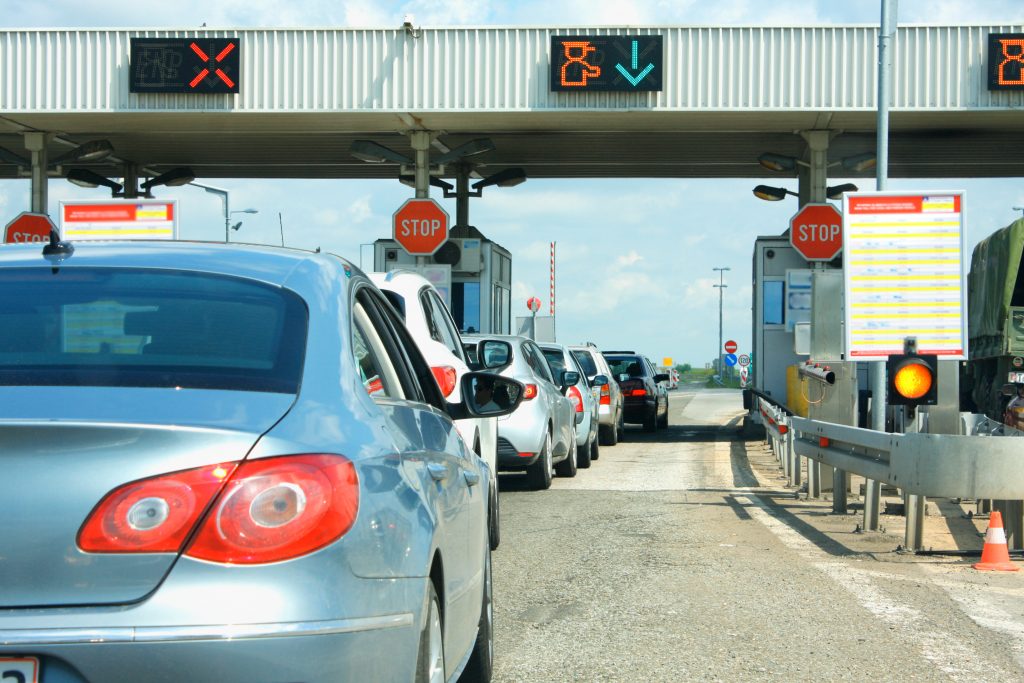
What is a Toll Fee?
A toll is a fee that is legally imposed by the country or local government for having the right to pass through an overpass, route, or passageway. This fee is utilized as a kind of highway pricing to recover a portion of the expenditures of highway development and upkeep. Toll fees in the Philippines are fully regulated by the Toll Regulatory Board and collected to ensure optimum maintenance of these highways.
What is an Expressway?
A freeway or expressway is a limited-access route designed for high-speed connectivity and large-scale traffic without traffic signals, intersections, or commercial accessibility. A highway, on the other hand, is a major public route with traffic lights, junctions, and commercial access for a larger amount of vehicles.
What are Highways?
A non-highway may also have extensive lengths without any junctions. However, highways often have reduced speed restrictions and can pass across populated areas with traffic lights, pedestrians, or alternative, less rapid transportation.
Expressways in the Philippines
- Metro Manila Skyway
- NAIAX – Ninoy Aquino International Airport Expressway
- NLEX – North Luzon Expressway
- NLEX Harbor Link
- TPLEX – Tarlac-Pangasinan-La Union Expressway
- CLLEX – Central Luzon Link Expressway
- SFEX – Subic Freeport Expressway
- SCTEX – Subic-Clark-Tarlac Expressway
- SLEX – South Luzon Expressway
- C5 Southlink Expressway
- CAVITEX – Manila–Cavite Expressway
- CALAX – Cavite–Laguna Expressway
- MCX – Muntinlupa-Cavite Expressway
Vehicle Classification of Toll Rates in the Philippines
Class 1 Vehicles
These are vehicles that have two axles and a maximum total height of 7.5 feet. Compact cars, automobiles, tractor-trailers, and motorcyclists are examples. Unless you drive a huge vehicle such as a charter bus or caravan, you are most certainly in this category.
- SUV/AUV
- Car
- Van
- Motorcycle (400cc and up)
- Pick-up
- Jeepney
Class 2 Vehicles
In this category, vehicles have two axles but a height of more than 7.5 feet. This category includes big rigs such as public transportation buses and shipment trucks.
- Trailer Cars
- Trucks
- Bus
Class 3 Vehicles
This group is for large vehicles with a minimum of six wheels and a height of more than 7.5 feet. Unless you work in the delivery or transportation industry, you are unlikely to fall into this category.
- Large Trucks
- Trailer Trucks
Toll Fees in the Philippines
NAIAX
The NAIAX connects the Skyway to Ninoy Aquino Avenue, Macapagal Boulevard, New Seaside Drive, and the Manila-Cavite Expressway via Andrews Avenue, Electrical Road, and NAIA Road.

SKYWAY
The Metro Manila Skyway System (MMSS), sometimes known as the Skyway, is an overhead roadway that serves as Metro Manila’s principal expressway. It links the North and South Luzon Expressways (NLEX and SLEX) and provides a connection to Ninoy Aquino International Airport.
Class 1

Class 2

Class 3

NLEX-SCTEX
The freeway, which comprises the main portion and its several branches, is 101.8 kilometers long and runs from its northern end in Sta. Ines Interchange to its southern end in Balintawak Interchange, which is close to the Skyway, a high-speed toll road that links the NLEX to its southern equivalent, the South Luzon Expressway.
Class 1
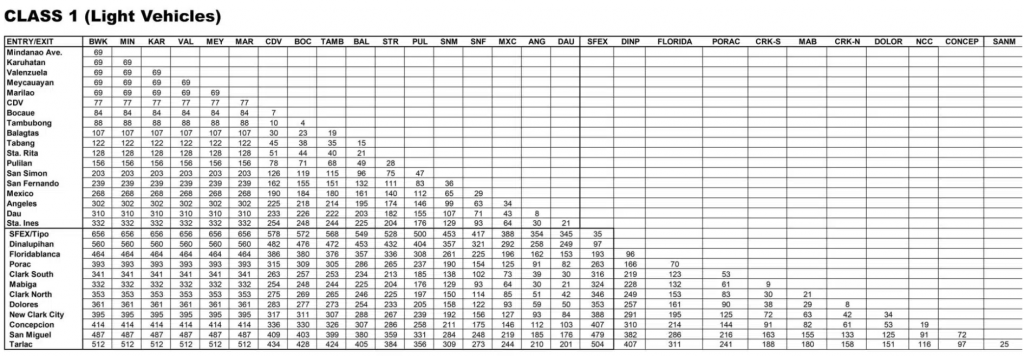
Class 2
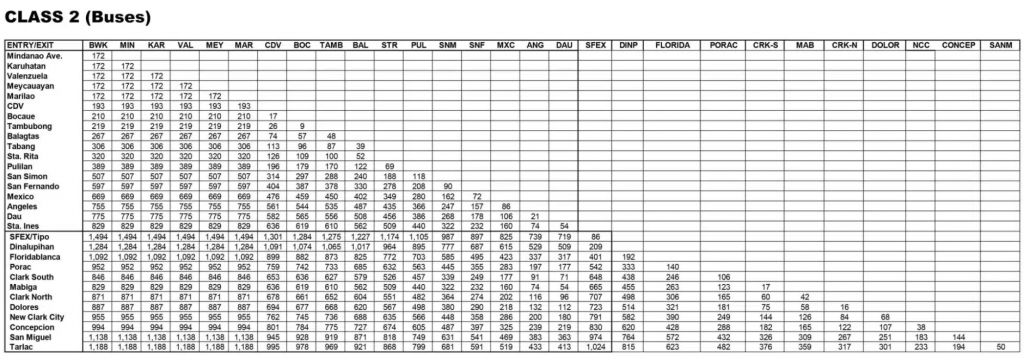
Class 3
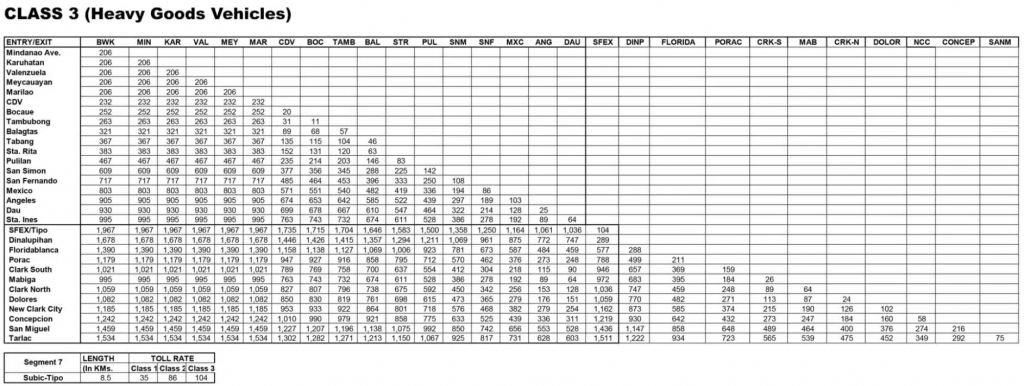
TPLEX
Section 1
Section 1 will stretch 48.7 kilometers from Tarlac City to Rosales. It will be four lanes long and divided into five sections: Tarlac-Victoria, Victoria-Gerona, Gerona-Paniqui, Paniqui-Moncada, and Moncada-Carmen.
Section 2
The second section, which includes the Agno viaduct, will be 9.47 kilometers in length and will link Rosales to Urdaneta through four lanes.
Section 3
The third portion will be 30.41 kilometers in length and will have four lanes from Urdaneta to Rosario. It will be split into two separate parts: Urdaneta-Pozzorubio and Pozzorubio-Roasario.
Class 1

Class 2

Class 3

SLEX
The South Luzon Expressway (SLEX) is made up of three separate freeways that interconnect Metro Manila to a number of provinces in South Luzon. It runs from Makati to Muntinlupa and then from Muntinlupa towards Batangas.
Class 1

Class 2

Class 3

CAVITEX
The roadway is a significant utility corridor, transporting electrical power lines and water distribution lines through the highly populated neighborhoods of Paranaque and Las Pinas.

CALAX
The Cavite-Laguna Expressway (CALAX or CALAEX), denoted as E3 on the Philippine expressway system, is a partially functional controlled-access toll highway in the Philippines’ provinces of Cavite and Laguna.
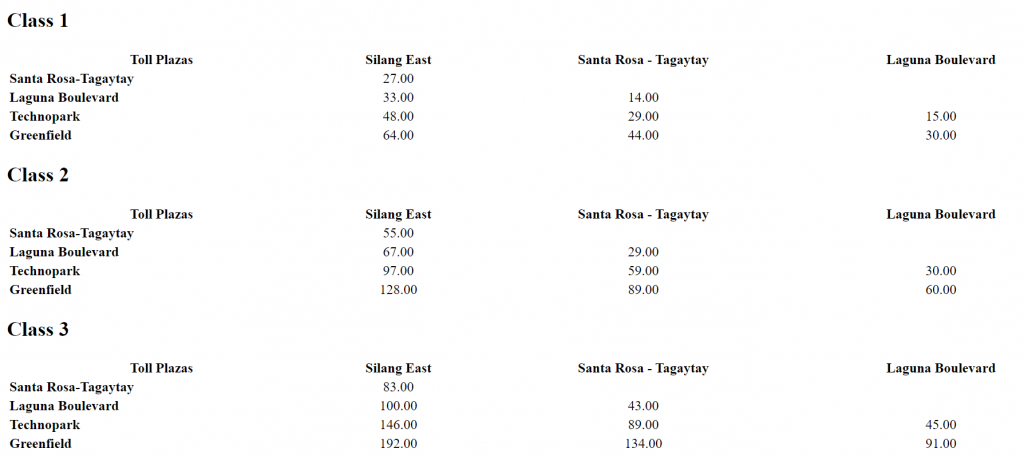
STAR
The Southern Tagalog Arterial Road (STAR), sometimes known as the STAR Tollway, is a 41.9-kilometer two-to-four-lane controlled-access toll highway in the Philippine province of Batangas. STAR Infrastructure Development Corporation (STAR – IDC) manages it. Along with the South Luzon highway and unidentified parts of the Skyway, the highway is designated as E2 on the Philippine highway system.
Class 1

Class 2

Class 3

Payment for Toll Rates in the Philippines
Toll fees in the Philippines can be paid in a variety of ways, including cash, debit cards, and RFID. Radio Frequency Identification is a form of digital payment that makes toll payments simpler and more efficient. Drivers must place an RFID tag on their car and link it to an electronic wallet in order to utilize RFID. Here are some of the benefits and drawbacks of each payment method:
Toll Cards
Toll cards are refillable cards that may be utilized for paying tolls. They are a more efficient means of payment than cash, but they must be topped up before usage.
Cash
This is the most usual method of paying tolls. However, it is time-consuming and may necessitate motorists carrying adequate cash.
RFID
This form of payment provides for a quicker and easier toll making a payment, but it does need an initial installation cost and the creation of a digital account.
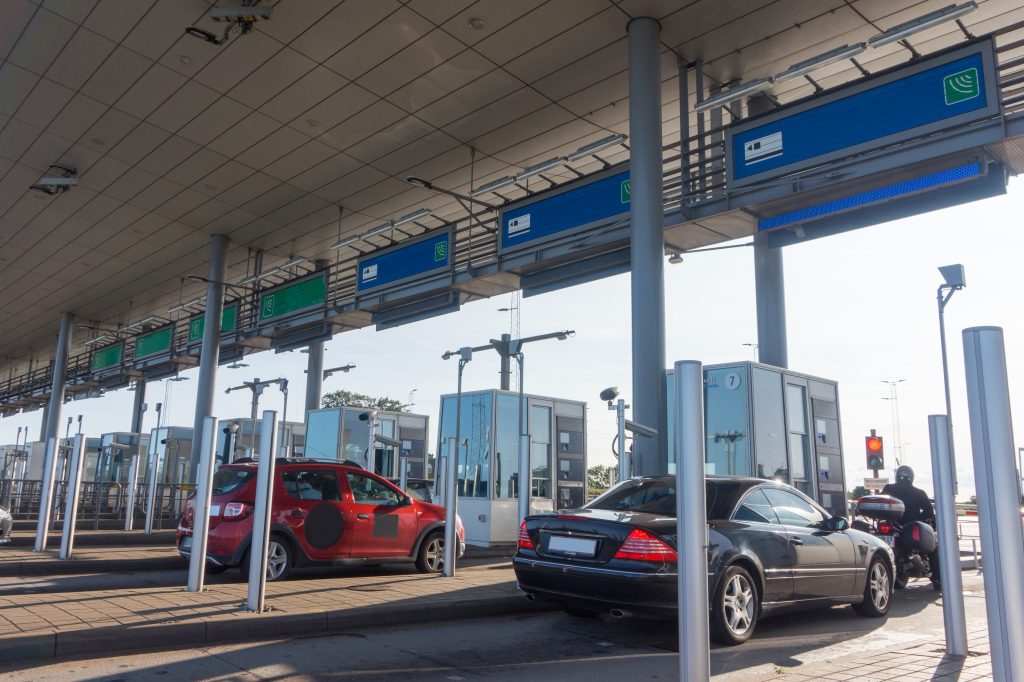
Tolls may appear to be needless, yet they are critical to maintaining our major freeways operational and secure. When you want to get away from the concrete jungle, or if you need to do errands for business in one of our neighboring provinces, remember to factor toll fees into your holiday expenditure. With this in mind, you can utilize the different payment methods that can help make your travel journey easier!









